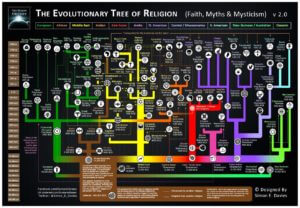
History of Religion - How Has It Evolved?
 12. 04. 2018
12. 04. 2018

Since the dawn of humanity, people have been trying to look for a sense of existence, especially when they have faced unknown phenomena such as storms or have asked questions such as:Will Pose be with us after death?"And"How did the world arise?'. It is likely that such questions have evolved into our first primitive religions.
The oldest evidence of religious practice is 100 000 for years when we began burying our dead. Although this can not be considered the beginning of faith, it suggests that mankind began to take into account posthumous life.
Over time, this religious practice became the basis for a new ideology extended to all continents today known as “animism".
This emerging belief was a system of belief that evolved and resulted in many other ideologies around the world. The Way of Evolving Religions can be divided into three classic periods.
It should be noted that these periods do not suggest a new ideology that improves on the basis of previous belief systems. Religions have changed over time, extinct and divided into different traditions. They adapt to their environment, partly by themselves, they are a natural part of evolution.
1.) Period - animism (100 000 pnl - present)
People started to believe that natural creatures (e.g., plants, animals, rocks and wind) they have a spiritual nature. They believed that these spiritual entities have the power that influences our everyday life, and that by worshiping these divine beings we can maintain harmony with the spiritual world and gain from it the same benefits.
2.) Period - polytheism (15 000 pnl - present)
The roots of polytheism can extend to the end of the Paleolithic. According to so-called nostrational theory, all languages share a common ground in a single language family, which has apparently influenced all African and Eurasian dialects. Many of the basic words include natural gods (such as Mother Earth and Father - Sky).
This suggests that a new generation of gods has evolved from the natural spirits of animism (which gave human beings more and more thunder and water). During the Neolithic Revolution civilizations emerged with new industries (for example, legislation, metallurgy, agriculture and commerce). And, in the place of old Indo-European or Sumerian gods, new guides have entered the civilized world.
these divine beings were usually divided into several classes, which overshadowed the heavens, the riches of the dead, and the underworld. Every deity has its own powers and religious practice (eg, trading, diplomacy, war, etc.).
One could either worship one or all of these beings and to receive grace from them through sacrifices and prayers.
3.) Period - monotheism (1348 pnl - present)
In the Bronze Age, a new movement emerged, favoring one god over all other deities. This system is known as "monotheism“- belief in one divine being.
In the year 1348 pnl Pharaoh Achnaton began to worship a lesser known god called "Aton"And put all the other Egyptian gods in the background. A little later, the Persian priest Zoroaster Ahuru Mazduza declared the only supreme god.
This new system consisted of the fact that one god - creator created a known universe and he was completely self-sufficient, able to rule over everything. This idea has become key in Judaism, Christianity, Islam and Sikhism.
In most monotheistic systems, something is exceptional, and the gods of the old world have to be removed from the consciousness of man. As a result, monotheistic religions have shown less religious tolerance than polyteist religions, which has led to many wars and disputes.






 5
5